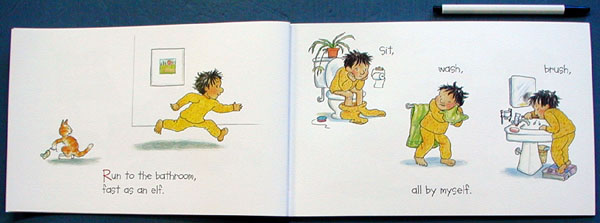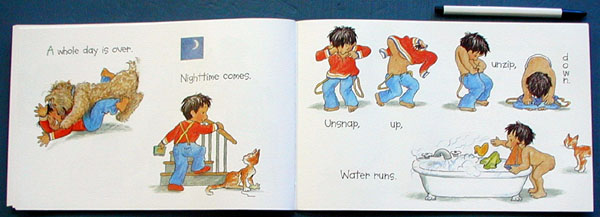|
|
|
|
 |
 이전 | 이전 |  목록 | 다음 목록 | 다음 |
|
확대 이미지 : 상세그림 1

|
확대 이미지 : 상세그림 2

|
확대 이미지 : 상세그림 3

|
[ 책 소개 ]
모든 일은 스스로 해봐요! 스스로 모든 일을 하는 아이의 행동을 통해 독립심과 자주성을 키울 수 있는 책입니다.
피터는 일어나서 잠들기 전까지 너무나 바쁜 하루를 보내게 됩니다. 아침이 되었네요~ 욕실로 달려가서(Run), 변기에 앉고(Sit), 씻고(Wash), 양치질을 하고(Brush), 옷을 갈아입고, 단추도 잠급니다(Snap). 청바지를 끌어 당겨서 입고(Pull), 단추를 잠그고 지퍼도 올립니다. 오른쪽(Right), 왼쪽(Left) 신발을 신고 끈을 묶고(Tie). 빗질(Comb)도 했어요. 끝(Done)! 이제 아침을 먹어야겠죠? 우유를 붓고(Pour), 시리얼을 아삭아삭 맛있게 먹습니다(Crunch). 이제 학교에 가서 블록을 짓고(Build), 그림을 그리고(Paint), 글을 쓰고(Write), 노래를 부릅니다(Sing). 신나는 하루에요(Fun all day)! 이제 집으로 가야 해요. 집에서 피터가 스스로 해야 할 일은 무엇일까요?
기본적인 동사를 위주로 한 문장이 매우 간결하고 쉽습니다. 아이들이 꼭 알아야 할 동사와 단어를 한번에 배울 수 있습니다.
페이퍼백입니다.
[ 서지 정보 ]
Reading level: Baby-Preschool
Edition: Paperback: 32 pages
ISBN: 0064462536
책 크기: 28cm x 17.8cm
[ 영문 서평 ]
Book Description
Run to the bathroom, fast as an elf. Sit, wash, brush, all by myself. There are all sorts of things independent children can do--dress, undress, button, zip, scrub, rub, paint, and write--all by themselves. This is Aliki's exuberant celebration of the joys of mastering these skills--morning, noon, and night.
Annotation
A child shows all the things he has learned to do all on his own.
Horn Book
The mantra of young children everywhere is acted out with gusto in this enthusiastic picture book that zips along with a little boy as he goes about his day. Aliki lets his dog and cat make more frequent appearances than his parents, furthering the satisfying impression that he is accomplishing everything on his own.
Publisher's Weekly
A perky preschooler (or kindergartner) flies solo through his daily routine in this upbeat offering, which begins with a wake-up visit from the boy's pet cat. As the child washes up, gets dressed, eats breakfast, plays at school, goes to the library, etc., he is pictured on his own. Only in frames depicting his drop-off at and pickup from school and at bedtime do his parents appear. The parents' limited role reinforces the book's celebration of children's independence, even if it sometimes presents a skewed perspective of age-appropriate autonomy. The text is simple and the picture clues are ample, but the verse's rhythm and rhyme scheme are intermittently forced (e.g., "Right shoe, left shoe. Tie, comb, done! Breakfast's ready, pour, crunch, yum!"). Aliki's (William Shakespeare & the Globe) brightly hued, unadorned art convincingly conveys the protagonist's high energy and enthusiasm. A cheerful if minor addition to the author/artist's oeuvre.
Children's Literature
Aliki provides a delightful look at a very busy day in the life of Peter. Her book shows him being awakened by his car and then going through his morning routine of washing, dressing and enjoying breakfast before he heads off to school. The text is often just a few words describing the actions Aliki has depicted. The boy is obviously enjoying every moment. He does everything with gusto and seems to have boundless energy. The really important message is that most of what he does, he carries out by himself. Young kids struggling with dressing and undressing will look to Peter as a real role model. How do we know his name? Because he hangs up his jacket with his name written over the peg. The back cover has a chart and asks kids what they can do by themselves. It might be fun to make a color copy and use it as a chart to keep track of progress that your child or a group of kids make over a certain period of time. Lots of fun and a nice choice for libraries, both personal and public or school. 2003 (orig. 2000), HarperCollins, Ages 3 to 6. - Marilyn Courtot
School Library Journal
Just as the title implies, this jubilant story shows and tells about a child doing all sorts of things independently. "Right shoe,/left shoe./Tie,/comb,/done!/Breakfast's ready,/pour,/crunch,/yum!" The boy goes through a typical day, getting dressed, going to school, visiting the library, practicing his violin, helping with dinner, and getting ready for bed. Aliki's colorful illustrations closely match the moods and energy levels of a five- or six-year-old. The youngster's dog and cat have almost as much personality as he has. The text has a hand-printed appearance, large and easy to read. The back cover features a chart labeled, "What can you do all by yourself?" with verbs such as wash, brush, button, zip, tie, pour, build, and write. A good choice for storyhours and beginning readers.
Kirkus Reviews
Essentially a followup to Robert Kraus's Leo the Late Bloomer (1971) and like tales of developing competency, this follows an exuberant child from morning washup to lights out at night, cataloguing the tasks and skills he has mastered. Activities include dressing himself and joining in school activities, choosing his own books, helping with dinner and other household responsibilities, and taking a bath alone before bedtime. In Aliki's sunny, simplified pictures, it's a child's world, seen from low angles and with adults putting in only occasional appearances. Like the lad, the fitfully rhymed text gallops along, sometimes a little too quickly—many illustrations are matched to just a word or two, so viewers aren't always given much time to absorb one image before being urged on to the next—but underscoring the story's bustling energy. Young readers and prereaders will respond enthusiastically to this child's proud selfassurance, and be prompted to take stock of their own abilities too.
|
| * 최근 이 작품을 구입하신 분들의 다른 선택 |
Stanley in Space
Flat Stanley, 페이퍼백, 슈퍼바이 |
Ada Twist's Big Project Book for Stellar Scientists
에이다의 40여가지 과학프로젝트책 |
And Now Miguel
Newbery 수상작, 페이퍼백, 슈퍼바이 |
Made by Maxine
하드커버, 슈퍼바이 |
|
| |
|
|